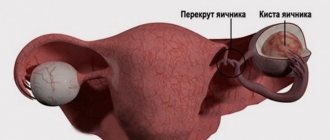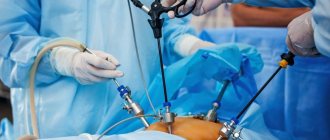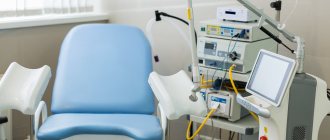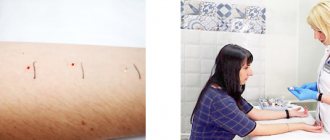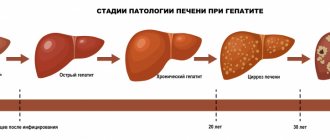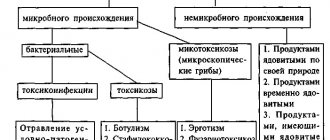Vaginal and Bartholin's gland cysts are formations on the vaginal wall or in its vestibule, filled with liquid secretion. A vaginal cyst can be located on the surface, but sometimes it penetrates deep into the tissue and can reach the size of a chicken egg. Its increase occurs due to the accumulation of serous or mucous contents in it. As for Bartholin gland cysts, their formation can be caused by their blockage, narrowing or overgrowth.
The gynecological service of CELT invites you to undergo diagnostics and treatment of cysts in Moscow. Our multidisciplinary clinic has been operating in the capital's market for more than 25 years and offers paid medical services of a high professional level. We guarantee correct and accurate diagnosis, as well as treatment in accordance with modern international standards.
At CELT you can get advice from a gynecologist.
- Cost of initial consultation - 3,000
- Cost of consultation with ultrasound - 4,200
Make an appointment
Definition of disease. Causes of the disease
A Bartholin gland cyst is a benign round cavity (a saccular formation with thin walls and the presence of secretions of varying consistency inside) formation in the lower third of the vestibule of the vagina as a result of a violation of the outflow of secretions from the cavity and its accumulation in it.
The cyst cavity stretched by secretions can have different sizes, reaching 7-9 cm in diameter. Bartholin gland cysts are observed mainly before the age of 30 years (hormonally active reproductive age) and account for 2% of all diseases of the female genital organs with actively functioning and hormonally dependent Bartholin glands.
Before we move on to the mechanism of development of this pathology, we will consider the normal anatomy and physiology of the Bartholin glands.
Bartholin's glands or large vestibular glands are located on both sides of the vestibule of the vagina, in its lower third in the thickness of the labia majora. They are a paired organ. They got their name in honor of the Danish anatomist Caspar Bartolin Jr. who discovered them. Their size is about 1.5-2 cm, the excretory duct of the Bartholin gland, 1.5-2.5 cm long, opens on the inner surface of the labia minora at the border of its middle and posterior third. In some cases, their atypical location occurs, for example, in the thickness of the labia minora [13]
The function of the Bartholin glands is to moisturize the mucous membrane of the vulva during arousal during sexual intercourse, which prevents it from becoming dry and painful during sexual intercourse. Due to the presence of mucin in the secretion, it has a bactericidal effect.
The main causes of this disease are frequent inflammatory processes in the genital area caused by specific and nonspecific microflora, such as staphylococci, streptococci, E. coli, and pathogens of sexually transmitted infections - gonococci, chlamydia, etc. Microorganisms that cause diseases are increasingly being isolated upper respiratory tract - streptococcus pneumoniae and influenza bacilli [2]
Ruptures of the soft tissues of the perineum during childbirth and trauma, surgical manipulations on the external genitalia (episiotomy - incision of the soft tissues of the genital slit during childbirth to prevent their rupture in an unfavorable place, followed by the application of raffia sutures, surgical perineoplasty - surgical plastic surgery of the soft tissues of the perineum, surgical labiaplasty - surgical plastic surgery of the labia in the form of reducing their size).
More often, in cultures of Bartholin gland cyst secretions, no growth of diagnostically significant flora is detected. The causative agents for inflammation of the Bartholin gland cyst and transition to an abscess (above we discussed the microflora leading to the causes of inflammation leading to the appearance of a cyst) can also be representatives of the normal microflora of the female genital organs, such as staphylococci, streptococci, E. coli, and pathogens sexually transmitted diseases - gonococci, chlamydia, etc. Microorganisms that cause diseases of the upper respiratory tract - streptococci pneumonia and influenza bacilli - are increasingly being isolated [2]
Often cysts can be preceded by acute bartholinitis - an inflammatory process of the Bartholin gland without blockage of the duct (cysts in this case develop both after treatment after some time, and in the absence of it.
What is a vaginal cyst?
Like any cyst (translated from Greek as bubble), a vaginal cyst is a sac lined with epithelium, attached to one of the vaginal walls and containing fluid: from light straw to dark brown in color. The size of such cysts ranges from small (about the size of a nut) to quite large (about the size of a chicken egg). Larger cysts cannot grow undetected and are usually treated before they become particularly large. Cysts grow from any wall of the vagina: anterior, posterior or lateral. Accordingly, they manifest themselves differently, depending on the location.
Symptoms
Bartholin gland cysts are common problems in women of reproductive age. Most often, women complain about aesthetic issues - asymmetry of the labia, swelling on one side of the labia majora. Cysts are usually asymptomatic and can be detected by a gynecologist during a routine examination. But in some cases (hypothermia, acute or subacute inflammatory process of the respiratory tract, acute or subacute inflammatory diseases of the genital tract, pelvic organs), they can increase and cause significant pain. Women with larger cysts may complain of discomfort when walking, sitting, and during sexual intercourse. If the Bartholin gland is functioning on the other side, the hydration of the vagina does not change during sexual intercourse. Due to blockage and the presence of a cyst, the Bartholin gland cannot fully function.[2] .[1]
Prevention of vaginal cysts
It comes down to the prevention of fetal development disorders (when it comes to congenital cysts) or interventions/inflammatory diseases (in relation to acquired cysts). In the first case, the pregnant woman’s recommendations are standard: avoid bad habits, infectious and inflammatory diseases, eat right, especially in the first months. Prevention of acquired cysts comes down to preventing the causes leading to them: timely treatment of infections/inflammations, injuries, incl. childbirth, proper rehabilitation after surgical interventions.
In any case, with this pathology, the most important thing is the observation of the attending physician and strict adherence to his recommendations.
Tags: Treatment of the cervix Consultation with a gynecologist Treatment of scars on the cervix Prenatal care
Pathogenesis
The resulting inflammation of surrounding tissues occurs in 3 stages:
Stage 1 - Alteration the release of fluid during Stage 2 - Exudation and blood cells from the vessels into the tissue, edema occurs.
Stage 3 - Proliferation (or productive stage) does not occur, since damaging factors continue to operate and therefore the resulting swelling, thickening of the walls, narrowing of the lumen of the canal, thickening of the secretion, resulting in blockage of the duct), the secretion of the Bartholin gland being produced, accumulating, thickening, leads to the formation of a cystic cavity formation, gradually increasing in size. Local defenses fail due to concomitant diseases, decreased general immunity and the aggressiveness of the flora that causes inflammation. Reaching a size of 4 or more centimeters, squeezing the surrounding tissues, causes pain in a woman and can, turning into an inflammatory process, cause an abscess of the Bartholin gland [2] [3] [4]
The causes and mechanism of development of Bartholin’s gland abscess are described below in the “Complication” section.
Signs of benign neoplasms inside the vagina
According to statistical studies, usually a vaginal cyst does not have any obvious symptoms and does not manifest itself in any way unless it is extremely large.
In the absence of systematic sexual intimacy, it is very possible that the presence of a neoplasm will be discovered only during a preventive examination by a gynecologist. One of the most common types of tumors that occur in the vagina is an epidermal cyst. It is very small in size and therefore difficult to notice. If the size of the cyst exceeds ten centimeters, the patient will complain of discomfort and the feeling of a foreign object in the vagina. During intimacy, sudden, severe pain appears. As the formation increases in size, problems with urination, accompanied by pain and pain, and stool problems due to compression of the rectum are possible.
When the tissues covering the tumor become ulcerated, the fluid inside becomes infected with pathogenic bacteria and pus is formed. The patient complains of an exacerbation of pain that occurs not only during intimacy. In addition, symptoms of inflammation of the vaginal mucosa (colpitis) appear, which include:
- sensations of irritation, burning and tingling localized at the entrance, on the front wall or on the back wall of the vagina;
- a feeling of heaviness that occurs mainly in the lower abdomen;
- discharge mixed with blood, the cause of which is not menstruation;
- change in color of the vaginal mucosa - it turns red;
- discharge of cloudy purulent exudate from the vagina.
Complications
1) Chronic bartholinitis - chronic inflammation of the vestibular gland for more than 3 months.
In this case, a formation in the area of the labia majora, accompanied by pain on palpation of the affected gland, redness, swelling of the tissues, can be both a complication and the primary cause of a Bartholin gland cyst. Treatment is aimed at destroying the causative agent of the disease and relieving symptoms of intoxication.
2) Bartholin gland abscess [1]
Under unfavorable conditions (secondary infection (migration of bacteria from nearby areas (genital tract, cervical canal, uterine cavity, urinary system or separate foci - oropharynx, respiratory tract), weakened immunity) the cyst suppurates with the development of a Bartholin gland abscess.
Body temperature, intoxication, and a sharp deterioration in health appear. Locally, there is an increase in the size of the formation from 10 to 12 cm, a feeling of fullness and sharp throbbing pain in the perineum. Any movement can increase the pain.
On palpation - fluctuation, increased skin temperature.
An abscess of the Bartholin gland can open spontaneously, releasing pus. Since abscess formation of a Bartholin gland cyst is often associated with sexually transmitted infections, there may be clinical symptoms of colpitis, urethritis, endocervicitis, the main symptoms of which are swelling and hyperemia of the mucous membrane, itching, leucorrhoea
The method of treatment is planned or emergency hospitalization, during which an autopsy is performed followed by drainage of the abscess, anti-inflammatory (broad-spectrum antibiotics), detoxification therapy.
3) Cyst recurrence occurs quite often in situations such as self-opening, surgical opening or puncture of the cyst.
1. Rectovaginal fistula as a complication of excision of the Bartholin gland. This is a pathological channel between the rectum and vagina as a result of ongoing inflammation and melting of surrounding tissues.
A rectovaginal fistula may occur after removal of the Bartholin gland. Case [12] illustrates a rare and serious complication of a commonly performed gynecological procedure
Patients may complain of pain in the perineal area, pain during sexual intercourse, or bowel movements. To establish and confirm the diagnosis, after collecting an anamnesis, conducting a gynecological and rectovaginal examination, additional examinations, and consulting a proctologist. The tissue defect is eliminated using an autograft, a biological collagen plug, or a titanium clip. If a fistula is detected during pregnancy, natural childbirth is prohibited. With adequate treatment, the prognosis is favorable.
2. Sepsis is a systemic inflammatory reaction in response to a local inflammatory process in the area of the Bartholin gland cyst. The response to the release of toxins formed during the destruction of harmful microorganisms in the absence of appropriate therapy is accompanied by a failure syndrome in many organs and systems, which can lead to death.
Happy stories
Polina
Sep 30 2021
Many thanks to your clinic and especially to Diana Omarovna!! IVF I got pregnant on the first try, my son is already 5 years old!!! I'll come again!!!
Read the story
Anna
28 Sep. 2021
We would like to express our deep gratitude and low bow to everyone who works in this clinic and, of course, to our doctor Aslanbek Ruslanovich Torchinov! On
Read the story
Svetlana
11 Sep. 2021
We would like to express our gratitude to the Fertimed clinic and in particular to the doctor from God Efimova Maria Sergeevna, she is our guardian angel thanks to her professionalism
Read the story
Sadovskaya-Shmeleva Tatyana Viktorovna
15 Jul. 2021
On May 4, 2021, a baby weighing 3150 grams and height 50 cm was born. This happiness cannot be expressed in words. Especially when the path to it is very long and difficult.
Read the story
Dzagoev family
May 03, 2021
Now I want to write my own story of happy motherhood. I have 9 years of infertility behind me, 4 IVF attempts, 3 of them were unsuccessful! 1 attempt was
Read the story
Svetlana
23 Feb 2021
I would like to express my deep gratitude to Tatyana Evgenievna Samoilova! Thanks to her, I am a happy mother! Our acquaintance began back in 2010, when
Read the story
Grineva Gulnaz
19 Feb 2021
I would like to express my deep gratitude to the doctor from God, Anna Anatolyevna Smirnova! It is thanks to her that we have been happy parents for five years now.
Read the story
Olga
23 Jan 2021
Our boy’s life began in Fertimed. Exactly 5 years ago they gave us his first photo, in it he was 8 weeks and 1 day old. What about us, future parents?
Read the story
Oksana
23 Dec 2020
I would like to express my gratitude to the MOON AND BACK to Diana Omarovna, Margarita Beniaminovna, Mikhail Yuryevich for our son, whose birth we are almost
Read the story
Natalia
29 Nov. 2020
I am 40, my husband is 49. We have a male factor, which makes it very difficult to get pregnant: most embryos stop on the 5th day of development. Except
Read the story
Elena
13 Nov. 2020
Our Moscow holidays were spent at the Fertimed clinic to fulfill our deepest desires. After endless attempts to get pregnant with...
Read the story
Marina
Oct 11 2020
It is impossible to express in words all the gratitude to our wizard - Torchinov Aslanbek Ruslanovich!!! Thanks to him, our baby was born on March 29, 2020.
Read the story
Irina
12 2020
I would like to express my deep gratitude to all the employees of this center for their professionalism. I would like to say a special HUGE THANK YOU to our doctor
Read the story
Orlova Olga Aleksandrovna and Chemodurov Dmitry Leonidovich
24 Jul. 2020
We would like to express our deep gratitude to all the doctors at this clinic! Thanks to you, we have two wonderful children growing up in our family - Zakhar (24.0
Read the story
Oksana
29 Jun 2020
Hello! We have an unusual story. My husband and I had our first children born in EB. Because We always wanted a very large family, so we decided not to stop..
Read the story
Evgeniya
May 16, 2020
My children are already 11 and 8 years old, but I periodically remember you with gratitude, dear Fertimed. Especially Anna Anatolyevna, Diana Omarovna, Margar
Read the story
Irina
17 Apr 2020
We owe our happy story to Anna Anatolyevna Smirnova! Thanks to her professionalism, our son was born. Anna Anatolyevna - they will notice
Read the story
Nikolai and Ekaterina
19 Feb 2020
Dear FertiMed, my wife and I want to sincerely thank the wonderful doctor, smart woman and great professional - Anna Anatolyevna Smirnova and sk
Read the story
Maria
10 Dec. 2019
Two years of unsuccessfully visiting doctors with my husband. We were advised to contact Zhordanidze Diana Omarovna in Fertimed. Wonderful doctor! Rezul
Read the story
Alipat
Oct 21 2019
Thanks to you, your clinic and Anna Anatolyevna Smirnova, I came to my cherished dream after 7 years of wandering from one doctor to another. Thankfully, I found out about
Read the story
Natalia
09 Oct 2019
I'll write a story too. 7 years of infertility, 3 IVF attempts. Out of desperation, I go and ask for a referral for laparoscopy. And in the intensive care unit I got into a conversation with a woman. TO
Read the story
Natalia
20 Feb 2019
Hello. I want to express my deep gratitude to your center. I got the impression of a close-knit team focused on results. Were treated by
Read the story
Andrey and Alexandra
14 Feb 2019
Many thanks from our entire large family to all the employees of the center for your work, for the smile on your face and faith in a positive result! Mihai
Read the story
Valentina
15 Jan 2019
My husband and I’s path to the happiness of being parents began in 2012 after the sounds of Mendelssohn’s wedding march died down. Like everyone else, we thought
Read the story
Catherine
May 16, 2019
After marriage, I couldn’t get pregnant at the age of 22; it turned out to be problems with the fallopian tubes. When I found out that I could never have anything on my own
Read the story
Olga
02 Mar 2019
I would like to express my deep gratitude to the FertiMed clinic, and especially to doctor Aslanbek Ruslanovich, for his good, caring attitude, and also for his
Read the story
Irina
23 Jun 2018
I would like to express my deep gratitude to the wonderful doctor of the FertiMed clinic, Aslanbek Ruslanovich Torchinov, for our long-awaited son. On hold
Read the story
Yuri
May 15, 2018
It will probably be an unusual review, since this is a review from a new father, and in general, I don’t really understand how I can express ours to you,
Read the story
Catherine
15 Dec. 2017
We first turned to FertiMed back in 2010, after 3 years of visiting doctors and undergoing all sorts of exotic tests. Unfortunately, the first
Read the story
Catherine
25 Sep. 2017
I got married at 22, my husband was 23, I never thought that there might be problems with conception, it turned out after I had appendicitis in childhood.
Read the story
Elena
May 23, 2017
My husband and I dreamed of having a child for 6 years. I have an adult daughter (20 years old) from my first marriage; my husband had no children. Passed several attempts at Eco in p.
Read the story
Elena
21 Feb 2017
My husband and I wanted more than anything to become parents, but time passed, wandering around to different doctors led to nothing, constant tests and treatment
Read the story
Nina and Peter
27 Sep. 2017
My husband looked at his spermogram as if it were a death sentence - not a single sperm count. And the reason is unclear. There was only one hope - for TEZU. It was explained to us that
Read the story
Faith
18 Jul 2016
I was ready to do anything to have a baby. By the age of 32, I had already undergone five operations on my ovaries and only one tiny piece remained from them. Nasty
Read the story
Maria
27 Jun 2016
I had two ectopics and no chance of having my baby. The irony was that my closest
Read the story
Valentina and Mikhail
Oct 14 2016
My husband and I flew from Kamchatka. They really wanted a second child. FertiMed was recommended by friends. They say that small and thin women like me have
Read the story
Sophia
27 Jul 2016
At FertiMed, at first they didn’t believe that I had 43 IVF attempts. There was clearly distrust and sympathy in the eyes of the staff - they say the woman went crazy.
Read the story
Alya
30 Sep. 2016
When I left my husband, with whom we had three children, no one, of course, could understand this, and no one wanted to. And even more no one could understand what m
Read the story
Valentina and Victor
01 Nov 2016
Our Dasha is growing up, at 1 year and 9 months she is a very smart girl, learning the alphabet on her own tablet (a real one, not a toy one)
Read the story
Christina
05 Apr 2016
I was 45 when I was ready for IVF. At the first meeting, the doctor at FertiMed said: there is no chance of having a child with my own eggs. At first there were sh
Read the story
Yana
13 2016
I am 29 years younger than my husband. He has three adult children, but I really wanted my child and ours together. Over the past few years, my husband has been very
Read the story
Anna
01 Mar 2016
I'm a happy mom! 5 years of standing with a birch tree, measuring basal temperature, tracking ovulation, hysteroscopy, laparoscopy (for my husband too), clostil
Read the story
Diagnostics
The diagnosis of a Bartholin gland cyst (including asymptomatic cases) is often made on the basis of an objective examination: asymmetry of the genital fissure, an increase in the volume of one or, less often, two labia majora. If the Bartholin gland cyst is not inflamed, the skin over it retains its normal color. Upon palpation, the gynecologist detects a slightly painful cystic formation of elastic consistency in the thickness of the labia majora.
Laboratory tests: not specific [3] (in blood and urine tests, if the cyst is uncomplicated by inflammation, there will be no changes
Instrumental studies: ultrasound of the external genital area reveals an anechoic or hypoechoic avascular (not reflecting or poorly reflecting ultrasound, on the screen we see a round formation with thin - light walls and completely dark or light suspended contents) formation with thin walls
List of main diagnostic measures at the outpatient stage:
1. General blood test;
2. General urine analysis;
These blood and urine tests are taken as part of the standard, to prepare for surgical treatment and to exclude concomitant pathologies from other organs with their subsequent correction)
3. Smear for microflora and degree of purity.
This is an examination method in which the test material is taken from the surface of the mucous membrane of the vagina, cervical canal and urethra. The purpose of the analysis is to assess the composition of the microflora and identify inflammatory diseases. The assessment of the standing of the natural flora has in its classification four degrees of vaginal cleanliness:
1st degree – epithelial cells and a normal number of lactobacilli in the smear, pH – acidic;
Grade 2 – a small number of leukocytes, fewer lactobacilli, gram-positive diplococci are present. pH – remains acidic;
3rd degree - increased number of epithelial cells and leukocytes, decreased lactobacilli, many coccal bacteria, pH - slightly acidic or alkaline;
4th degree – a large number of epithelium and leukocytes, pyogenic microorganisms, absence of lactobacilli, pH – alkaline.
4. Bacterioscopic examination of vaginal discharge and cyst contents - allows us to identify microbial agents that caused the Bartholin gland cyst: identification of the pathogen, sensitivity to antibiotics.
5. Testing for infections (ELISA, PCR) gonorrhea, trichomoniasis, chlamydia. [3]
The required scope of examinations before hospitalization:
1. Blood for antibodies to Treponema pallidum (this is the detection of total antibodies to the causative agent of syphilis) - a necessary test before hospitalization and surgery!!
2. Blood type and Rh factor.
3. General blood test.
4. General urine analysis.
5. Smear to determine the degree of purity.
6. Culture from the cervical canal.
7. HbsAg - surface antigen of the hepatitis B virus - to detect hepatitis B by its presence and determine its concentration, a necessary analysis before hospitalization and surgery!!
8. Anti HCV.
In women during menopause or perimenopause, an excisional biopsy is indicated to exclude adenocarcinoma, since at this age the risk of developing malignant tumors is greatest
Traditional recipes for the treatment of vaginal cysts
Vaginal wall cysts have virtually no tendency to become malignant. This is the main reason why it is permissible to use traditional medicine methods for their treatment. Before being treated by witch doctors and healers, undergo an examination and receive recommendations from gynecologists at the Yusupov Hospital.
In order to prepare an infusion from a collection of medicinal herbs, you need to take one spoonful of the following plant material:
- Salvia officinalis herbs;
- Stinging nettle roots;
- Herbs St. John's wort;
- Herbs are a series of tripartite, which must be collected at the beginning of flowering.
Add a tablespoon of aerial parts of sweet clover, wormwood herb, dill seeds, prickly tartar herb and common yarrow herb. Take one tablespoon of herbal mixture and pour a glass of boiling water. Cover the container with a lid, place on low heat and leave to simmer for three or four hours. Then strain the liquid through a fine sieve or use gauze folded in four for this purpose. Take the infusion for one year, half a glass three times a day after meals, two hours later, for one year. During treatment, visit a gynecologist for a preventive examination and monitoring the dynamics of cyst development in the vagina.
For the second collection, you need to take one teaspoon each of the herb tripartite, stinging nettle, tricolor violet, wormwood and St. John's wort, as well as the following ingredients:
- Greater burdock roots;
- Sandy immortelle flowers;
- Walnut leaves;
- Small centaury grass;
- Joster fruits.
To them add a tablespoon of knotweed herb, one teaspoon each of oregano, horse sorrel roots and valerian officinalis roots. Pour 3 tablespoons of the prepared mixture into three glasses of boiling water. Close the dish with a lid and wrap it with a thick cloth. Leave the mixture to steep for at least eight hours. Then strain the liquid through five layers of cheesecloth or a fine-mesh sieve. Take the resulting infusion for vaginal cysts, half a glass half an hour before meals four times a day.
For women who have been diagnosed with a vaginal cyst, traditional healers recommend a herbal mixture, which consists of the following components, taken in equal proportions:
- Violet flowers;
- Ground parts of the sequence;
- Nettle herbs;
- Walnut leaves;
- Artemisia herbs;
- Zhoster fruits;
- Oregano;
- Valerian roots;
- Horse sorrel roots.
To the resulting collection you should add four parts each of immortelle flowers, St. John's wort, centaury and knotweed, as well as burdock roots. Place two tablespoons of the mixture in a thermos and pour 400 ml of boiling water into it and leave overnight. The infusion should be taken 100 ml before meals for one month. The next course starts in a week. This is done until complete recovery. During treatment with traditional methods, women should periodically visit a gynecologist at the Yusupov Hospital.
Representatives of traditional medicine recommend using celandine and burdock juice and golden mustache tincture as methods of herbal medicine for vaginal cysts. Women squeeze the juice from the leaves of young burdock and drink one tablespoon three times a day, before meals. At night, a tampon moistened with the same juice is placed in the vagina. Milk slurry is used in the same way. In order to prepare it, you need to grind burdock leaves in a meat grinder and take them one tablespoon, 3 times a day, on the eve of meals. The duration of the course of therapy is one month.
Homeopathic medicines can contribute to the complete disappearance of cystic formations. In no case should you use ready-made complex homeopathic preparations, since when prescribing a particular remedy, the homeopath takes into account the individual characteristics of each patient. When taking homeopathic remedies and conventional medicines together, you can get a temporary unstable result. When treating with homeopathic medicines, you must be psychologically prepared to completely stop taking pharmaceuticals.
Differential diagnosis
Includes cystic and solid lesions of the vulva, such as epidermal inclusion cyst, hidradenoma papilliferum and lipoma [3], vulvar neoplasms; - abscess of the Bartholin gland; - bartholinitis; vulvar abscess.
— Hematoma in the vulva area – there may also be complaints about a formation in the vulva area, discomfort during sexual intercourse, and pain. But when collecting anamnesis; and gynecological examination - the woman associates its appearance with mechanical trauma, childbirth; And the location is not in the area of projection of the large vestibular gland. [1]
— Paraurethral cysts – similar complaints. On examination - swelling in the paraurethral region (the area near the urethra) [1]
- Furunculosis of the labia majora. Complaints include formations in the perineal area, general malaise, hyperemia, edema, hyperthermia. Upon examination, the formation is localized in the area of the hair follicle and sebaceous gland. [1]
Treatment
Small, asymptomatic cysts may not be treated except for cosmetic purposes.
Often the clinician is tempted to simply incise the cyst or abscess because this technique may be effective for other common abscesses. However, simply puncturing a cyst or abscess of the Bartholin gland can lead to a relapse, since the edges of the tissues, when punctured or cut, very quickly close again due to the rapid healing or regeneration process [6]
Only large cysts, usually 3 or more centimeters, which interfere with daily activity and sexual life, and disrupt the aesthetic appearance of a woman’s external genitalia, are subject to surgical treatment.
The main goal of surgical treatment is organ-preserving - the formation of a canal and restoration of the function of the Bartholin gland,
What types of operations exist
Doctors use the following types of surgical interventions to eliminate a cyst:
- the integrity of the tumor wall is broken (pierced) and the fluid inside is extracted (suctioned) using a special medical device - puncture aspiration;
- opening the neoplasm, removing its contents and circularly suturing the edges of its wall into the external wound - marsupialization;
- The mucous wall of the tumor is divided by ellipsoidal or longitudinal dissection, then the neoplasm is removed with the capsule (enucleation), and its location (bed) and the mucous membrane are connected with sutures using a special absorbable suture material made of catgut - this manipulation is called radical excision.
Needle aspiration is usually used if a woman is expecting a child and the tumor is significant. The results of such interventions are not permanent. After some time, the fluid appears inside the cyst again. The third technique carries the risk of damaging the walls of the bladder and rectum. As a result, the most common method of removing a tumor in the vagina is marsupialization. If transvaginal removal of the formation is unsuccessful, surgical intervention can be performed by dissecting the anterior abdominal wall (laparotomy) or by creating access through small holes in the abdominal cavity (laparoscopy).
Catheter placement – Word
This is a modern method of surgical treatment for Bartholin’s gland cyst, especially in case of its recurrence.
Under local anesthesia, the cystic area is opened with a small incision of about 5 mm, the contents are removed and sent for bacteriological examination, the cyst cavity is washed and a Word catheter is installed in it (this is a silicone tube 55 mm long, 5 mm in diameter with a channel inside, blindly ending, with thinner walls at the end, due to which the tip can inflate into a ball, which has no analogues), inflating its rubber tip to 3 ml with a physiological solution of 0.9% sodium chloride, thereby fixing it in the cavity of the cyst. For better fixation and prevention of loss during the woman’s movements, it is recommended to apply 2-3 absorbable interrupted sutures along the contour of the catheter emerging from the cavity of the cyst. The second end of the catheter is inserted into the vagina. The catheter remains in the cyst cavity for 6 weeks. This is aimed at forming a channel for the passage of secretions, the walls of which do not grow together. The study shows that the Word catheter is an easy-to-use, low-cost outpatient procedure with acceptable short-term recurrences. Treatment costs are seven times lower than with marsupialization [7]. While the catheter is in the cyst cavity, the patient is advised to have sexual rest to avoid its loss. In a number of countries there is no such restriction, since studies have shown that the pain symptom caused by both the cyst itself and the procedure performed with the catheter in the cavity completely disappears over time (by day 6) [8]
As an alternative, a Voroda or a Jacobi ring (the catheter does not have a channel, it is harder, shaped like a ring) which is installed through 2 punctures in the mucous membrane and capsule of the cyst and the 2 ends are fastened to each other.
Vaginal cyst removal
Most Gartner's duct cysts, Müller cysts, and inclusion cysts remain small, painless, and do not require treatment. If a vaginal cyst is discovered during a pelvic examination, your healthcare provider may recommend a pelvic ultrasound or MRI to diagnose it. Also, our doctors can show the patient the found find during the video colposcopy procedure and even take a photo of it. A biopsy may also be ordered to rule out cancer. Vaginal cysts that are enlarged, inflamed, or causing problematic symptoms should be removed surgically to prevent them from recurring in the future.
If your vaginal cyst is large and filled with fluid (such as a Bartholin's cyst), your healthcare provider may open it, drain it, and insert a small tube called a catheter to keep the cavity open so it can heal better. You will have to keep the catheter in place for about four to six days. Also, gynecologists make a small incision to drain the fluid, and then the edges of the incision are stitched to the sides of the incision.
You can also have surgery to remove a vaginal cyst if you are very uncomfortable or if it continues to return after treatment. Some health care providers recommend that women over 40 have surgery to remove certain types of vaginal cysts due to the possibility that they may be potentially cancerous. Usually these formations do not return after surgery.
Where to go in Moscow
Surgeries to remove vaginal cysts in Moscow are performed by gynecologists at our clinic.
After diagnosis, the manipulation is carried out by an experienced specialist under modern local anesthesia, eliminating any discomfort. The technique is radio wave surgery without the use of piercing and cutting instruments, exclusively radio wave exposure to tissue (it is bloodless and aesthetically appropriate). Complete healing and recovery within 7-10 days after opening. Clarification:
✔ If you want to get rid of this problem, sign up for a preliminary consultation with a leading specialist at our clinic!
